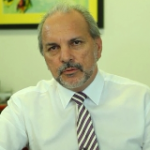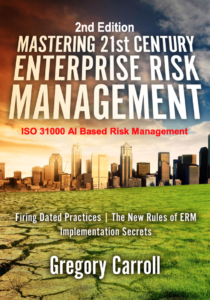 Greg Carroll has a graduate degree in Operations Research from Swinburne University. He has a certificate in Machine Learning from Stanford University and in Data Science from the University of Michigan. He has over thirty years’ experience in Enterprise Risk Management. He has applied risk management techniques to IT and Artificial Intelligence systems in mission critical environments like the Department of Defense and Victorian Infectious Disease Reference Laboratories.
Greg Carroll has a graduate degree in Operations Research from Swinburne University. He has a certificate in Machine Learning from Stanford University and in Data Science from the University of Michigan. He has over thirty years’ experience in Enterprise Risk Management. He has applied risk management techniques to IT and Artificial Intelligence systems in mission critical environments like the Department of Defense and Victorian Infectious Disease Reference Laboratories.
He was the founder and Technical Director of Fast Track (Australia) Limited. He has worked with multinational companies like Motorola, Fosters and Serco. This work included implementing pro-active AI and risk analytics solutions using deep learning to identify and classify risk, random forest & regression models for scenario analysis and Bayesian networks for aggregation of risk. He is the author of “Mastering 21st century Enterprise Risk Management”.
Although ISO 31000 defines risk as the uncertainty on corporate objectives, most risk management is primarily based on the administration of risk in risk registers, using risk matrix, and heat maps. This siloes risk preventing an Enterprise view necessary for ERM. Mastering 21st century Enterprise Risk Management is a call to action to transform business to managing risk proactively. This involves integrating multiple risk systems around corporate objectives, measuring risk by their value at risk, and aggregating to ascertain the real effect of uncertainty on corporate objectives, thereby fulfilling the primary directive of ISO 31000 . Being proactive comes from evaluating risk events, instead of risk items, using Scenario Analysis. This transforms risk management into a tool for risk-based decision-making allowing “what-if” modeling of effects of possible changes to a process.
- You are in the process of updating this book. What have been the major changes since initial publication in 2013?
The 2nd edition expands on the above concepts by integrating AI based Risk Management into the process. This includes using Bayesian techniques more widely from evaluating risk drivers to using Bayesian Decision Networks for modeling scenarios. It also suggests using machine learning techniques including neural networks for classification of risk, Explainability models for identifying causal factors, sentiment analysis for measuring risk culture and text analytics for monitoring regulatory compliance. Finally, I included uses for Big Data, IoT and Crowdsourcing for sourcing a greater depth of risk collateral.
- In correspondence you indicate that “Employee experience will become the primary focus if not equal to customer focus.” Would you explain why to believe this not be so?
Yes, I believe there are several reasons why the future focus of management will be on Employee Experience as opposed to the tradition customer focus.
Customers today are more demanding and more mobile. They prefer doing their own research and purchase decision-making, as opposed to traditionally relying on supplier “education” and relationships. This has killed what suppliers have for years relied on to build markets. From now on, markets will continually be disrupted and therefore volatile. Customer will want to ensure they are not buying into out-of-date solutions, so will search the market as part of their due diligence. i.e., the death of customer loyalty.
So, customer focus will move to market focus with personalized service. More than supplying customer needs, it will be necessary to service them at a personal level, per transaction. They may not return for their next purchase but without that personalized service they will not complete their current purchase!
So, what does this have to do with Employee Experience. Employee attitude will be critical to delivering personalized service, as well as the on-going innovation necessary for organizations to stay ahead of the disruption cycle. Yes, it’s a cycle. iTunes, an early disrupter of HMV and Virgin Records, has itself been disrupted by Spotify. As I covered in my book, innovation is not invention, but the new application of existing technologies to operational opportunities. This requires being front-line driven, not backroom research. Think Uber, Snapchat, Netflix. Once an idea is identified, then the backroom can develop it.
To those from Gen-X and before (like me), disruption, loss of customer loyalty and continual innovation seems scary. But to Gen-Y and Millennials, this is their staple diet. Their fertile imagination, low boredom threshold, and being fully connected 24/7 means they are always looking for “different”. Further, marketing is moving away from relationship building to social networking. Employee networks are replacing direct marketing, and influencers are replacing mass media. Work-Life balance for the new generations is not equal time for both, but an integration of the two. They are not only connected 24/7 but are working for your business 24/7, if you can convert them to your evangelists.
It is a win-win situation, if you can transform your business model to being Employee Experience focus. A staff of 200 evangelists promoting your business 24/7 through 1000+ social media connections each, puts your marketing on steroids. In return they expect to be wowed, pampered, socially responsible, and promoted. They will return the effort 10-fold through loyalty, innovation, and providing exceptional customer service. Think Apple and Google today.
- How has COVID changed the way people work and what adjustments must organizations make going forward?
The new buzzword is “Anywhere Operations”. The real interesting thing I see is that many organizations have already transformed. This changes the traditional early adopters-laggards model to simply winners and losers. Winners know working from home, counterintuitively works. Studies are showing up to 15% productive gains from workers at home. Losers are waiting for the return to the old days.
Working from home will probably scale back to 3 days a week, with 2 days in office for social and training issues. But this will most likely be spread over the full 7-day week for different employees, based on their needs.
Businesses have completed the forced digital transformation and are now looking for ways to capitalized on it. The new view is business will be transacted on-the-road. Sighting client problems, meeting in coffee shops, “dialing-in” while traveling, will all join working from home as the new point of business. Apart from bricks-and-mortar savings, it utilizes dead traveling time, provides customers with personalized service, and allows employees the flexibility to meet their work-life balance goals.
